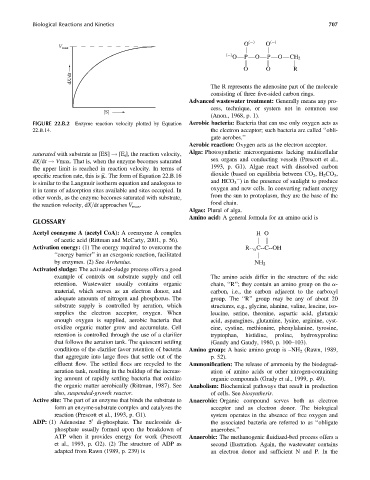Page 752 - Fundamentals of Water Treatment Unit Processes : Physical, Chemical, and Biological
P. 752
Biological Reactions and Kinetics 707
O ( ) O ( )
V max
j j
( )
O P O P O CH 2
k k j
O O R
dX/dt
The R represents the adenosine part of the molecule
consisting of three five-sided carbon rings.
Advanced wastewater treatment: Generally means any pro-
cess, technique, or system not in common use
[S]
(Anon., 1968, p. 1).
FIGURE 22.B.2 Enzyme reaction velocity plotted by Equation Aerobic bacteria: Bacteria that can use only oxygen acts as
22.B.14. the electron acceptor; such bacteria are called ‘‘obli-
gate aerobes.’’
Aerobic reaction: Oxygen acts as the electron acceptor.
saturated with substrate as [ES] ! [E t ], the reaction velocity, Alga: Photosynthetic microorganisms lacking multicellular
dX=dt ! Vmax. That is, when the enzyme becomes saturated sex organs and conducting vessels (Prescott et al.,
the upper limit is reached in reaction velocity. In terms of 1993, p. G1). Algae react with dissolved carbon
specific reaction rate, this is bm. The form of Equation 22.B.16 dioxide (based on equilibria between CO 2 ,H 2 CO 3 ,
is similar to the Langmuir isotherm equation and analogous to and HCO 3 ) in the presence of sunlight to produce
it in terms of adsorption sites available and sites occupied. In oxygen and new cells. In converting radiant energy
other words, as the enzyme becomes saturated with substrate, from the sun to protoplasm, they are the base of the
the reaction velocity, dX=dt approaches V max . food chain.
Algae: Plural of alga.
Amino acid: A general formula for an amino acid is
GLOSSARY
Acetyl coenzyme A (acetyl CoA): A coenzyme A complex HO
of acetic acid (Rittman and McCarty, 2001, p. 56). jk
Activation energy: (1) The energy required to overcome the R-- a C--C--OH
‘‘energy barrier’’ in an exergonic reaction, facilitated j
by enzymes. (2) See Arrhenius. NH 2
Activated sludge: The activated-sludge process offers a good
example of controls on substrate supply and cell The amino acids differ in the structure of the side
retention. Wastewater usually contains organic chain, ‘‘R’’; they contain an amino group on the a-
material, which serves as an electron donor, and carbon, i.e., the carbon adjacent to the carboxyl
adequate amounts of nitrogen and phosphorus. The group. The ‘‘R’’ group may be any of about 20
substrate supply is controlled by aeration, which structures, e.g., glycine, alanine, valine, leucine, iso-
supplies the electron acceptor, oxygen. When leucine, serine, theonine, aspartic acid, glutamic
enough oxygen is supplied, aerobic bacteria that acid, asparagines, glutamine, lysine, arginine, cyst-
oxidize organic matter grow and accumulate. Cell eine, cystine, methionine, phenylalanine, tyrosine,
retention is controlled through the use of a clarifier tryptophan, histidine, proline, hydroxyproline
that follows the aeration tank. The quiescent settling (Gaudy and Gaudy, 1980, p. 100–103).
conditions of the clarifier favor retention of bacteria Amino group: A basic amino group is –NH 2 (Rawn, 1989,
that aggregate into large flocs that settle out of the p. 52).
effluent flow. The settled flocs are recycled to the Ammonification: The release of ammonia by the biodegrad-
aeration tank, resulting in the buildup of the increas- ation of amino acids or other nitrogen-containing
ing amount of rapidly settling bacteria that oxidize organic compounds (Grady et al., 1999, p. 49).
the organic matter aerobically (Rittman, 1987). See Anabolism: Biochemical pathways that result in production
also, suspended-growth reactor. of cells. See biosynthesis.
Active site: The part of an enzyme that binds the substrate to Anaerobic: Organic compound serves both as electron
form an enzyme substrate complex and catalyzes the acceptor and as electron donor. The biological
reaction (Prescott et al., 1993, p. G1). system operates in the absence of free oxygen and
ADP: (1) Adenosine 5 di-phosphate. The nucleoside di- the associated bacteria are referred to as ‘‘obligate
0
phosphate usually formed upon the breakdown of anaerobes.’’
ATP when it provides energy for work (Prescott Anaerobic: The methanogenic fluidized-bed process offers a
et al., 1993, p. G2). (2) The structure of ADP as second illustration. Again, the wastewater contains
adapted from Rawn (1989, p. 239) is an electron donor and sufficient N and P. In the

